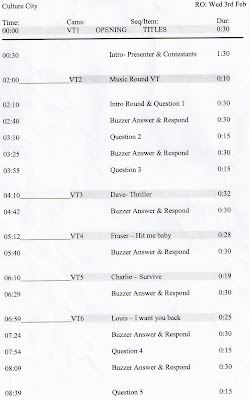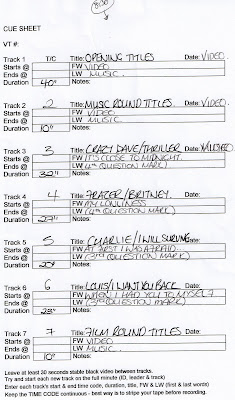Week beginning 18/1/10
This week we have started to get are quiz show togther. we have now finally decided on a name, the name of are show will be called "Culture City", with are title in place we have then started work on the back drops of our show. We came up with the idea of having a city landscape but the light was darkenend and so there was a siloutte over the city.
In are own groups with have 4 roles, one of which is content producer(who is overall in charge of our round), Post-Production producer (who is in charge of the VT's and if there are any questions which involve a video clip or a blurred image then that is what they do. there is also the technical producer who makes sure that things are possible, and finally the art director. in our group Luke took the role of content producer, Dave as technical producer, Tom as art director. As for myself i choose post- production manager. So far in our group we have got the layout of are round. The round starts off with one team having 60 seconds in which they answer as many questions as they can. the winning team goes first. Then the losing team goes second to see if they can catch up. We have also said that at the end of the round if someone started out reading the question they may finish reading out the question.
Week begining 24/1/10
This week we have started to paint are set, we have also come up with a name as well. The name of our show is Culture City. We came up with the name by thinking what all of our rounds were and then throught of a a catchy second word we had the same leter and noise at the front. We have also recorded our opening titles. We our opening titles we have got a collection of stuff which you would probably see in a students bedroom. We then placed it all on a table and filmed all of the items. We have also come up with an idea about what to do on the stings, we will basically just take some of the oening titles and narrow it down a bit. For our logo we have come up with the idea of a crossword logo, where we will get the culture and city to meet on the t's. Finaly we have been working on the set, the set is looking really good as we have a dark city we a silouette around the night sky, on that same board we have a supension bridge. On the other pieces of set we have we are going to use tall buildings and again give another silouette surronding them.
1/2/10
Today we have been getting ready for are final production on Wednesday, people have been working hard on the production. Some people have been setting up the set as we have finished the painting, we have now got 5 pieces of set not including the tables chairs plus the landscape piece of set which will go in front of the table. Other people have been working on the cue cards which the presenter (which we decided on Bobby Emanuel) will be holding to know what questions to ask. In the afternoon we were doing a rehersal using the previous groups questions and VT's, i did not participate in this as i was doing the DVD which will contain all TV inserts, all stings, opening credits, closing credits and the break in and out graphics.
2/2/10
Today i managed to put all of the tracks on the DVD, in afternoon we had rehearsals and so i joined in on these. For most of the rehearsals in that afternoon i was DVD ops, this was not as easy as it would seem. We were using the DVD which the other group made, there's was called Media Meltdown. Using the DVD player was not the problem it was the timings as each VT had to have a VT ident after it, this ident usually lasted about 5 seconds, the problem we faced is that some VT's needed to be played very quickly after each other and we were restricted as to how fast you could play the VT's. We also got given our roles in Wednesdays show i will be the DVD ops in the first half of the show, i am pleased with my role as i should do it well as i helped make the DVD.
3/2/10
Today was supposed to be the day when we were recording our show but due to the DVD we couldn't record today. The DVD was finished as i had put all of the tracks and VT idents in but the problem was that it was going to take a while to write it to DVD and so we did not get to practice our show until the afternoon, again we had small problems with smaller parts but again the main problem with the show was the DVD, as there was not enough time for you to move it onto the next track. We all decided at the end of the the day that we should come in at half past 10 the following day.
4/2/10
The morning started off fairly well as most people where in on time, the DVD was ready to play and everyone had been given their role. As before we were in at half past 10 again to get some last minute rehersals. In the morning the practice went well but again the main problem was the DVD as it was to slow to keep up with the show, we then came up with the idea of slowing the show down a bit and getting the host to talk more and getting some small conversations in. We had a 45 mintue lunch break to get even more rehersals in and then it came to the final show. The final show started off well as everything went occording to plan, i was on the first half doing the DVD ops. In the first half there were no slip ups everything went well. In the second half again there were no slip ups everything went occording to plan. After the show we did have a talk about what went well and what could be improved and the only thing anyone said was that one of the contestants was a little quite but apart from that everything was perfect.









